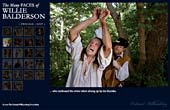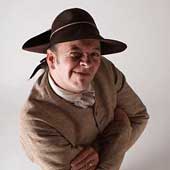Page content
Online Extras
Willie Balderson Slideshow

Willie Balderson Animation

The Many Faces of Willie Balderson
A Photo Essay
It was as a vagabond chicken thief that William Balderson came first to the notice of some Colonial Williamsburg readers. Eight years have passed, but perhaps you recall it. Before a wooden coop, checking over his shoulder, a bold and sly expression in his eyes, crouched an urchin dressed in tatters and grasping a squawking hen. That was Willie, as he usually is called.
The journal later caught Balderson in the act of throttling in her sleep his pregnant wife, Trish, and strung him up by his thumbs until he confessed her murder. Once the journal had him hanged, though for an unrelated felony, and hauled his ashen corpse off the gallows in a tumbrel.
Balderson had appeared in these pages before, and would again, as, among other things, a Confederate soldier, the 1700s York County surveyor Robert Lucas, one Mr. Tuttle of the Royal Optick Show and master of the dancing Quaker puppet, a dropped-dead-in-the-woods Jamestown colonist, a helmeted and armored seventeenth-century soldier, 1620s Indian-language interpreter Henry Spelman, and Meriwether Lewis of Thomas Jefferson’s Corps of Discovery.
Balderson is a man of many characters, costumes, talents, and faces.
The Colonial Williamsburg Foundation’s manager of public history development, Balderson has been interpreting historical figures since 1976, when as a twenty-two-year-old college journalism student, he took a summer job with Richmond’s National Battlefield Park portraying a Union soldier. That, he says, is when he “realized here was this incredible medium called living history.” Though after graduation—he switched his major to history, by the way—he had regular work at the Richmond Newspapers, he improved his nights and weekends posing as people of the past for the National Park Service, museums, historical societies, and schools. In 1986, Balderson became a full-time contractor, and in 1997, he signed on with Colonial Williamsburg.
For one client or employer or another, he’s also portrayed a Richmond gentleman of the 1840s, a War of 1812 army officer, a nineteenth-century ship’s captain, a Welsh crewman of the USS Monitor, a 1600s indentured servant, an eighteenth-century Virginia burgess, and Raleigh Tavern barkeeper John Lockley.
To each role, he brings the resources of a walk-in closet full of period clothing, the just right tonsorial, and a repertoire of expressions practiced before a mirror. “It’s all about the read,” Balderson says. The idea is to help people see not Willie Balderson, but the character he has assumed.
“The sole intent of interpretation is to provoke,” he says. “To cause them to think about something in a different light.”
In this photo essay, Balderson is seen by the light reflected in the lenses of Colonial Williamsburg photographers Dave Doody and Tom Green.
– Alexander Chesterfield
